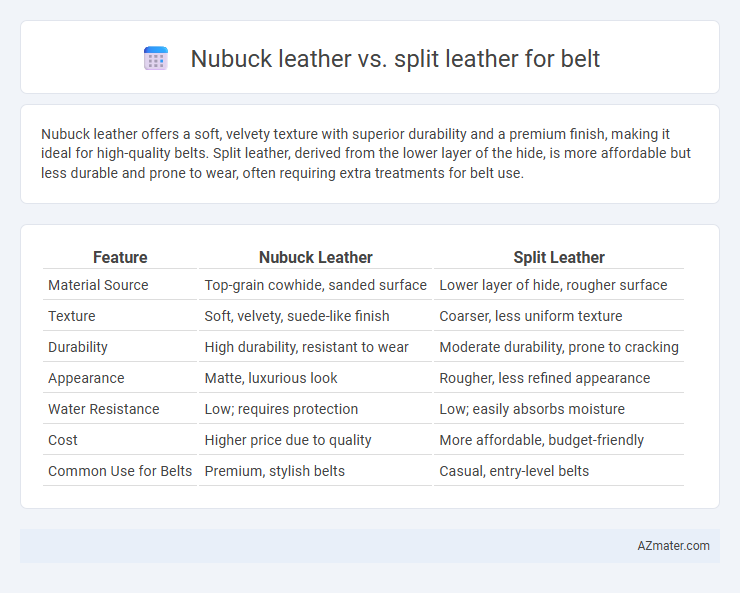Nubuck leather offers a soft, velvety texture with superior durability and a premium finish, making it ideal for high-quality belts. Split leather, derived from the lower layer of the hide, is more affordable but less durable and prone to wear, often requiring extra treatments for belt use.
Table of Comparison
| Feature | Nubuck Leather | Split Leather |
|---|---|---|
| Material Source | Top-grain cowhide, sanded surface | Lower layer of hide, rougher surface |
| Texture | Soft, velvety, suede-like finish | Coarser, less uniform texture |
| Durability | High durability, resistant to wear | Moderate durability, prone to cracking |
| Appearance | Matte, luxurious look | Rougher, less refined appearance |
| Water Resistance | Low; requires protection | Low; easily absorbs moisture |
| Cost | Higher price due to quality | More affordable, budget-friendly |
| Common Use for Belts | Premium, stylish belts | Casual, entry-level belts |
Overview of Nubuck Leather and Split Leather
Nubuck leather is crafted from the outer layer of the hide, offering a velvety, soft texture with a fine grain and high durability, making it ideal for premium belts that combine style with resilience. Split leather originates from the fibrous lower layer of the hide, featuring a rougher surface that is often coated or embossed to imitate full-grain leather, producing more affordable belts but with less natural strength and breathability. The choice between nubuck and split leather belts depends on preferences for appearance, durability, and price, with nubuck providing a luxurious finish and split leather delivering cost-effective options.
Key Differences Between Nubuck and Split Leather
Nubuck leather for belts is made by sanding the outer grain layer to create a velvety, soft texture, offering durability and a premium appearance. Split leather, derived from the lower layers of the hide, lacks the grain surface and is typically less durable and more prone to wear when used for belts. Key differences include nubuck's higher quality, strength, and smooth finish compared to the rougher, less resilient nature of split leather belts.
Appearance and Texture Comparison
Nubuck leather features a soft, velvety texture with a matte finish due to its top-grain sanding, offering a premium and plush appearance ideal for stylish belts. Split leather, derived from the lower layer of the hide, has a rougher, coarser texture and typically lacks the refined look of nubuck, often appearing more fibrous and less uniform. The superior grain structure of nubuck enhances durability and aesthetic appeal, making it a preferred choice for high-quality belt craftsmanship.
Durability and Strength: Which Lasts Longer?
Nubuck leather, crafted from the outer layer of the hide, boasts a dense grain structure that offers superior durability and strength compared to split leather, which originates from the inner layers. Split leather tends to be less robust and more prone to wear and tear, making it less ideal for high-stress applications like belts. Consequently, belts made from nubuck leather generally last longer and maintain their structural integrity over extended use.
Comfort and Flexibility in Belts
Nubuck leather, crafted from the outer grain, offers superior comfort and flexibility for belts due to its soft, velvety texture and natural breathability, allowing it to mold comfortably to the wearer's body. Split leather, derived from the inner layers, tends to be stiffer and less breathable, often requiring more break-in time, which can reduce initial comfort and limit flexibility in belts. For users prioritizing a comfortable, flexible belt that adapts quickly to movement, nubuck leather provides a more premium and ergonomic experience compared to split leather.
Maintenance and Care Requirements
Nubuck leather requires regular brushing with a soft brush to maintain its velvety texture and avoid dirt buildup, while it should be protected from excessive moisture and direct sunlight to prevent discoloration. Split leather belts demand more frequent conditioning with leather oils or creams due to their looser fibers, which are more prone to drying out and cracking. Both types benefit from storage in a cool, dry place away from sharp bends to preserve belt shape and longevity.
Cost and Value for Money
Nubuck leather belts typically come at a higher price due to their superior quality, velvety texture, and durability compared to split leather. Split leather belts are more affordable but lack the strength and refined finish of nubuck, making them less cost-effective over time. Investing in nubuck leather offers better long-term value for money because of its resilience and premium appearance despite a higher upfront cost.
Best Uses for Nubuck Leather Belts
Nubuck leather belts offer a velvety texture and refined appearance ideal for casual and semi-formal wear, providing durability without compromising style. Best suited for settings where subtle elegance and softness are valued, Nubuck belts resist wear while maintaining breathability and comfort. Unlike split leather, Nubuck's top-grain quality ensures long-lasting strength and a premium look for belts used in everyday or light outdoor activities.
Ideal Applications for Split Leather Belts
Split leather belts excel in durability and affordability, making them ideal for casual and workwear applications where cost-effectiveness and resilience are important. Their fibrous texture allows for a sturdy build that resists wear from frequent use, making split leather belts suitable for heavy-duty tasks or everyday wear. These belts are commonly chosen for styles that require a rugged appearance without the premium price point of full-grain or nubuck leather.
Which Leather Is Better for Belts?
Nubuck leather offers a soft, velvety texture due to its top-grain quality and slight sanding, making it more durable and resistant to wear compared to split leather, which comes from the lower layers of the hide and tends to be less strong and prone to stretching. For belts, nubuck leather provides a premium feel with enhanced longevity, while split leather belts often require additional finishing or bonding to improve appearance and strength. Choosing nubuck leather ensures a more resilient, aesthetically pleasing belt that withstands daily use better than split leather options.

Infographic: Nubuck leather vs Split leather for Belt
 azmater.com
azmater.com